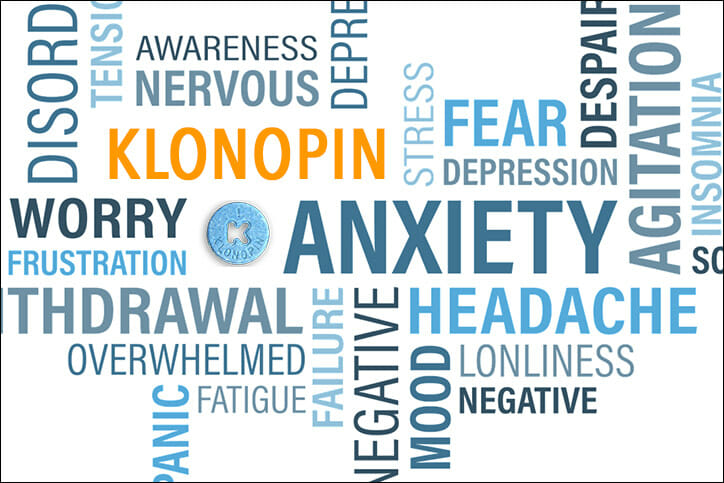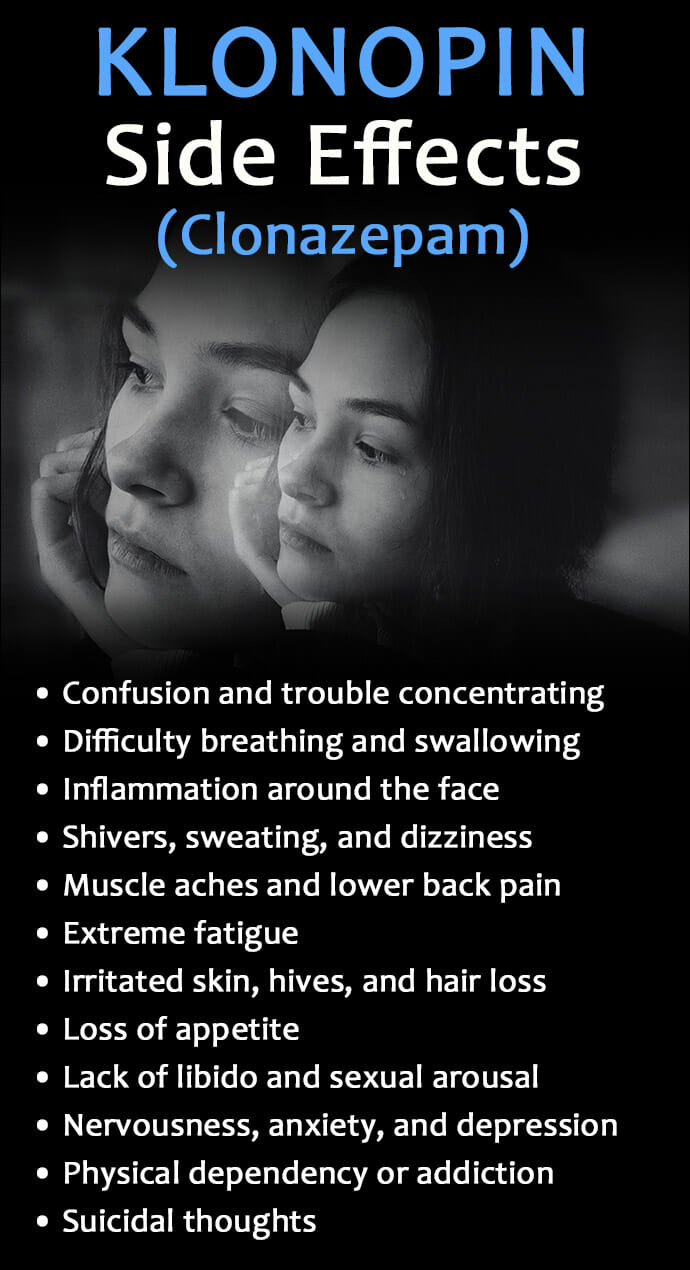Misusing any drug recreationally can be potentially harmful, although abusing benzodiazepines is extremely dangerous, and the feeling produced by the Klonopin high or other benzos is a cause for concern.
While the numbers may be low, in 2020 it was reported that nearly 5 million people over the age of 12 years old misused benzodiazepines like Klonopin, according to the 2020 National Survey on Drug Use and Health.
What is Klonopin (Clonazepam)?
Klonopin is the brand name of the generic drug Clonazepam, a type of benzodiazepine similar to Valium or Xanax.
Like some other benzodiazepines, Klonopin is often prescribed to people suffering from anxiety disorders or panic attacks. It can be also useful in the treatment of insomnia and epilepsy-related seizures.
Benzos are a central nervous system depressant that enhances GABA activity in the brain, meaning the medication slows down rapid-firing neurons that can lead to seizures, increased anxiety, and panic.
In other words, the Klonopin high has a tranquilizing effect. This is why benzodiazepines, like clonazepam, can be extremely habit forming and dangerous, especially when taken for more than the prescribed period of time or when mixed with other depressants like alcohol.
Related: 7 Tips For How to Increase GABA Naturally Without Drugs
How Long Does Klonopin Stay in Your System?
Klonopin, unlike some other benzodiazepines, takes longer for the body to process and is not as intense as medications like Xanax, which more quickly enter the bloodstream.
Peak concentrations of clonazepam in the bloodstream can take anywhere from one to four hours, depending on the individual taking the drug.
Because of it’s longer half-life, patients taking Klonopin do not need to take it as often as other benzodiazepines and the effects of the drug can last up to 12 hours in some cases.
With that said, Clonazepam or Klonopin can stay in your system for much longer than the effects of the Klonopin high. It may show up on blood tests for up to five days and urine tests for two weeks to a month depending on the dose and frequency of use.
Clonazepam Side Effects
Taking Klonopin as prescribed is critical because the medication can come with some unwanted side effects, particularly when a person takes a higher than recommended dose or mixes it with other drugs or alcohol.
Common clonazepam side effects can include:
- Confusion, trouble concentrating, poor coordination, and double vision
- Difficulty breathing and swallowing
- Inflammation around face, eyes, lips, and tongue
- Vomiting, shivers, sweating, and dizziness
- Muscle aches, lower back pain, and extreme fatigue
- Irritated skin, hives, and hair loss
- Loss of appetite and inability to taste food
- Lack of libido and ability to become sexually aroused
- Increased nervousness, anxiety, and depression
- Physical dependency on the drug that can lead addiction
- Suicidal thoughts
Many of these symptoms require immediate medical attention, especially because permanent damage can occur without medical attention.
When a person taking Klonopin is trapped in a cycle of dependency, whether from taking the drug as prescribed for long periods of time or from misusing the drug, it can be particularly difficult to stop because withdrawal from clonazepam can be extremely painful and uncomfortable.
Klonopin / Clonazepam Withdrawal Symptoms
Becoming physically dependent and addicted to benzos can happen without a person realizing it. Misusing or abusing the medication may not seem like particularly risky behavior at first, in part because the Klonopin high has such a calming, and disarming effect.
Once the brain and body are dependent on the drug, however, getting past the grip of any benzos can be incredibly difficult and dangerous.
In fact, healthcare experts do not recommend that people addicted to benzodiazepines give up the drugs “cold turkey” because severe withdrawal symptoms can be dangerous, and in some cases, even fatal.
Symptoms of Clonazepam / Klonopin withdrawal can include some of the following:
- Extreme physical cravings
- Increase in anxiety and panic attacks
- Rapid shifts in mood, from depression to irritability
- Problems focusing and concentrating or experiencing confusion
- Sleep disruption, such as the onset of severe insomnia
- Sweating, shakes, shivers, and tremors in the body
- Seizures or coma
- In severe cases, death can occur
The extreme discomfort and fear of Klonopin withdrawal drives many users to continue using the drug despite their addiction and unwanted side effects.
Klonopin withdrawal and detox should be done in a medically supervised environment.
Acute clonazepam withdrawal symptoms, the stage when a person is the most physically vulnerable to health complications, can last anywhere from five to 14 days.
After acute withdrawal, however, many patients may still experience severe anxiety. This is because it can take the brain two weeks to six months to return to its normal functioning to produce natural anxiety inhibitors.
The physical and mental symptoms of Klonopin withdrawal will usually improve with time, though getting through detox and withdrawal is just the first step.
Those with a benzodiazepine use disorder typically need substance addiction treatment to make a full recovery.
Klonopin Withdrawal and Detox Treatment
The first step in recovery from Klonopin dependence or addiction is detox in a benzo withdrawal treatment facility that provides a medically supervised environment.
Patients in some cases are given other prescription drugs that can help ease Klonopin withdrawal symptoms, though it’s important that medical staff be on hand in case of serious health complications, such as a seizure or coma.
Proper drug detox for all substances is necessary for a safe and comfortable recovery, but it is even more essential when dealing with withdrawal from benzos like Klonopin.
After the acute-withdrawal phase, the work of full recovery can get started with individual counseling, group therapy and, if appropriate, family therapy. All of these will explore the underlying root of addiction and use techniques to manage the behavior.
Cognitive Behavioral Therapy (CBT) is an evidence-based talk therapy that has shown to be exceptionally effective in helping people manage and overcome triggers that may lead to relapse.
Ideally, patients will recover at an inpatient residential facility that offers full-time support during recovery and an experienced medical team of professional addictionologists.
Because the effects of Klonopin withdrawal can take longer than other substances, it’s crucial to monitor each person’s progress at every phase of treatment and recovery to ensure he or she stays on track, and to get ahead of any complications that may arise.






